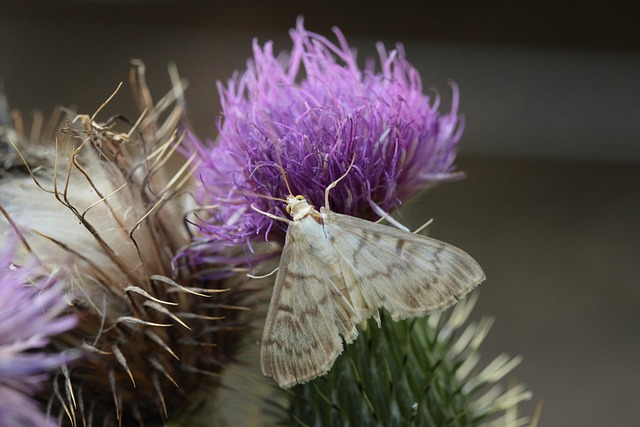Clothes moth infestations, often unnoticed due to their tiny size and hiding places within fabrics, can cause significant damage to stored items and trigger allergies. Professional cleaning services are vital for effective control, employing specialized equipment to remove eggs, larvae, and moths. Homeowners should watch for signs like webbing and holes and seek timely professional assistance. These services use advanced methods, including dusting, vacuuming, and insecticidal treatments, ensuring thorough elimination. A multifaceted approach combining regular deep cleaning, natural repellents, inspections, and post-treatment maintenance is crucial for long-term protection. Preventive measures like maintaining cleanliness, organizing fabric storage, and using natural deterrents or pheromone traps further minimize the risk of reinfestation.
“Clothes moths can cause significant damage to textiles, leaving behind eggs and larvae that pose a continuous threat. This article delves into the essential role of professional cleaning and sanitation in effective clothes moth control services. We explore the impact of infestations and how specialized cleaning methods eliminate eggs and larvae, providing long-term protection for your valuable fabrics. By understanding these processes, you can ensure a safe and clean environment for your garments.”
Understanding Clothes Moth Infestations and Their Impact
Clothes moth infestations can go unnoticed for extended periods, as these tiny creatures and their larvae often hide within fabrics. They feed on natural fibres, including wool, silk, and certain types of plant-based materials, making them a common pest in homes with storing garments, curtains, or furniture. The impact of an infestation extends beyond damage to fabrics; clothes moths can also trigger allergies and respiratory issues for sensitive individuals due to the fine dust particles they produce during their life cycle.
Professional cleaning and sanitation services are crucial for effective clothes moth control. These experts employ specialized equipment and treatments to remove eggs, larvae, and adult moths, ensuring a deep clean that traditional methods might miss. By understanding the subtle signs of an infestation—such as webbing in corners or small holes in fabrics—homeowners can seek timely assistance from these services, preventing further damage and maintaining a hygienic living environment.
The Role of Professional Cleaning in Clothes Moth Control
Professional cleaning and sanitation play a pivotal role in effective clothes moth control services. Clothes moths are notorious for laying their eggs in fabric, carpeting, and upholstery, leading to infestations that can be challenging to eliminate. Professional cleaners employ specialized techniques and chemicals that go beyond standard home cleaning. These methods include thorough dusting to remove webbing and egg cases, deep vacuuming to suck up larvae and moth debris, and the use of insecticidal powders or sprays that target both visible moths and their hidden eggs.
By enlisting the help of professional cleaning services, homeowners can ensure a more comprehensive and efficient approach to clothes moth control. These experts have the necessary equipment and expertise to navigate hard-to-reach areas, such as floor crevices and furniture seams, where moths tend to breed. Regular professional cleanings not only curb current infestations but also create an environment less conducive to future moth activity, providing long-lasting protection for homes and businesses.
Effective Sanitation Practices to Eliminate Moth Eggs and Larvae
Moth eggs and larvae can lay dormant in fabrics, carpeting, and other materials, posing a persistent threat to home and business environments. To ensure effective clothes moth control services, it’s crucial to implement robust sanitation practices. Regular deep cleaning, including the use of specialized equipment like vacuum cleaners with HEPA filters, is essential to remove any visible eggs or larvae. Additionally, treating affected areas with natural repellents like lavender or cedar oil can help deter moths from returning.
Beyond routine cleaning, identifying and addressing the source of infestation is key. Clothes moth control services often involve a thorough inspection to pinpoint where the moths are breeding. Once located, professional services may employ targeted treatments using safe, non-toxic chemicals to eradicate eggs and larvae at their root. Regular maintenance and monitoring post-treatment are also vital to prevent reinfestation and ensure a clean, sanitized space.
Preventive Measures and Regular Maintenance for Long-Term Protection
Implementing preventive measures and regular maintenance is key to long-term protection against clothes moths and their damaging effects. One of the most effective strategies is to maintain a clean and organized environment, especially in areas prone to fabric storage or clothing accumulation. Regularly vacuum high-risk zones, focusing on corners, edges, and crevices where larvae and eggs might hide.
Additionally, storing fabrics in breathable containers or bags can help regulate moisture levels, making it less favorable for moth activity. Utilizing clothes moth control services that employ natural repellents or pheromone traps can also be beneficial. These methods disrupt the breeding cycle by preventing moths from laying eggs or attracting them away from valuable items, ensuring a more sanitary and moth-free environment over time.
In conclusion, a comprehensive approach to clothes moth control involves a combination of understanding infestations, professional cleaning, effective sanitation, and preventive measures. By employing clothes moth control services, removing eggs and larvae, and maintaining a clean environment, you can effectively manage and prevent future moth-related issues. Regular maintenance is key to ensuring a pest-free wardrobe and home.
